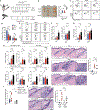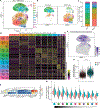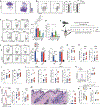Regulatory T cells in skin mediate immune privilege of the hair follicle stem cell niche
- PMID: 38181095
- PMCID: PMC11003870
- DOI: 10.1126/sciimmunol.adh0152
Regulatory T cells in skin mediate immune privilege of the hair follicle stem cell niche
Abstract
Immune tolerance is maintained in lymphoid organs (LOs). Despite the presence of complex immune cell networks in non-LOs, it is unknown whether self-tolerance is maintained in these tissues. We developed a technique to restrict genetic recombination to regulatory T cells (Tregs) only in skin. Selective depletion of skin Tregs resulted in T cell-mediated inflammation of hair follicles (HFs). Suppression did not rely on CTLA-4, but instead on high-affinity interleukin-2 (IL-2) receptor expression by skin Tregs, functioning exclusively in a cell-extrinsic manner. In a novel model of HF stem cell (HFSC)-driven autoimmunity, we reveal that skin Tregs immunologically protect the HFSC niche. Finally, we used spatial transcriptomics to identify aberrant IL-2 signaling at stromal-HF interfaces in a rare form of human alopecia characterized by HFSC destruction and alopecia areata. Collectively, these results reveal the fundamental biology of Tregs in skin uncoupled from the systemic pool and elucidate a mechanism of self-tolerance.
Conflict of interest statement
Figures







References
-
- Kyewski B, Klein L, A Central Role for Central Tolerance. Annual Review of Immunology. 24, 571–606 (2006). - PubMed
-
- Anderson MS, Venanzi ES, Klein L, Chen Z, Berzins SP, Turley SJ, von Boehmer H, Bronson R, Dierich A, Benoist C, Mathis D, Projection of an immunological self shadow within the thymus by the aire protein. Science. 298, 1395–1401 (2002). - PubMed
-
- Gallegos AM, Bevan MJ, Central tolerance: good but imperfect. Immunol Rev. 209, 290–296 (2006). - PubMed
-
- Mueller DL, Mechanisms maintaining peripheral tolerance. Nat Immunol. 11, 21–27 (2010). - PubMed
-
- Krishnamurty AT, Turley SJ, Lymph node stromal cells: cartographers of the immune system. Nat Immunol. 21, 369–380 (2020). - PubMed
Publication types
MeSH terms
Substances
Grants and funding
LinkOut - more resources
Full Text Sources
Molecular Biology Databases
Research Materials
Miscellaneous

